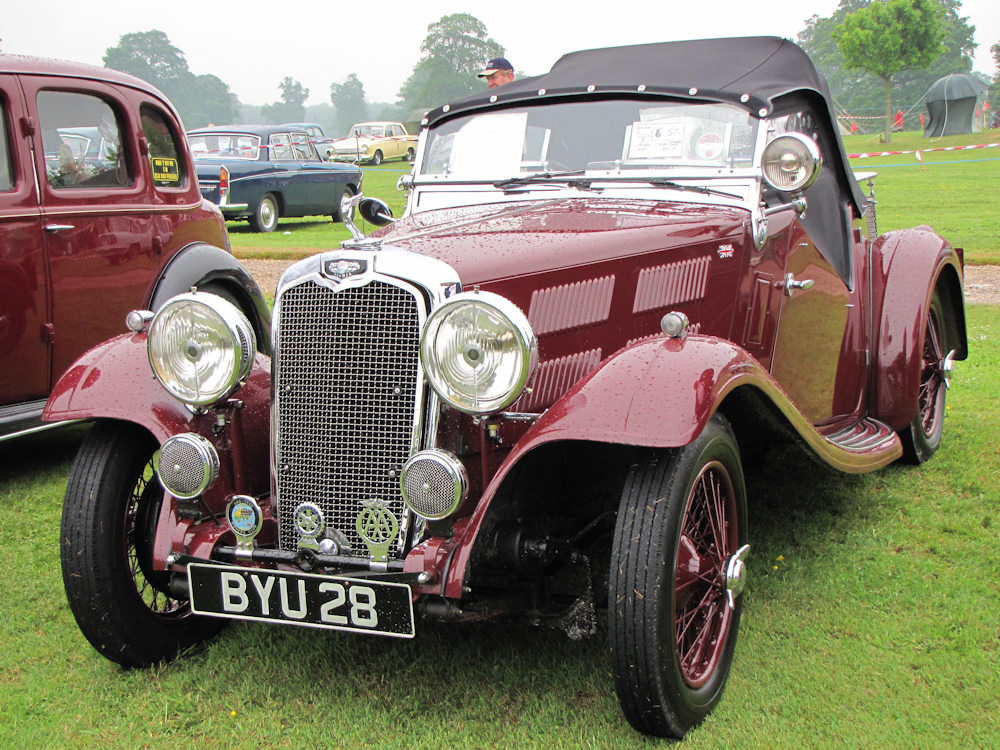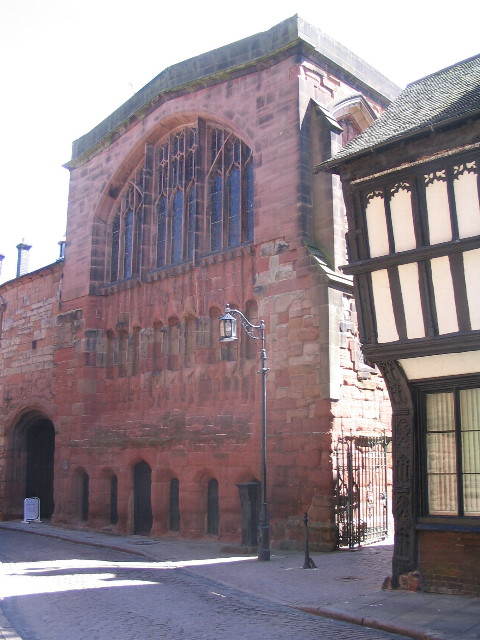|
Triumph Gloria
The Triumph Gloria is a car which was produced by the Triumph Motor Company in Coventry, England, from 1934 to 1938. History Between 1934 and 1938 Triumph made a large and complex range of Gloria sporting saloons, coupés, tourers, 2-seater sports cars, drophead coupés and golfer’s coupés. All these Glorias, apart from the final two models (1.5-Litre Saloon and Fourteen (1767 cc) Six-Light Saloon of 1937-1938) were powered by 1087 or 1232 cc four-cylinder or 1467 or 1991 cc six-cylinder Coventry Climax overhead inlet and side exhaust valve designed engines (modified and built under licence by Triumph). The chassis came in two lengths, with an extra ahead of the passenger compartment depending on whether the four- or six-cylinder engine was fitted, and had conventional non-independent suspension with semi elliptic leaf springs. The brakes were hydraulically operated using the Lockheed system with large drums. A four-speed transmission was fitted with an optional free whee ... [...More Info...] [...Related Items...] OR: [Wikipedia] [Google] [Baidu] |
Triumph Motor Company
The Triumph Motor Company was a British car and motor manufacturing company in the 19th and 20th centuries. The marque had its origins in 1885 when Siegfried Bettmann of Nuremberg formed S. Bettmann & Co. and started importing bicycles from Europe and selling them under his own trade name in London. The trade name became "Triumph" the following year, and in 1887 Bettmann was joined by a partner, Moritz Schulte, also from Germany. In 1889, the businessmen started producing their own bicycles in Coventry, England. Triumph manufactured its first car in 1923. The company was acquired by Leyland Motors in 1960, ultimately becoming part of the giant conglomerate British Leyland (BL) in 1968, where the Triumph brand was absorbed into BL's ''Specialist Division'' alongside former Leyland stablemates Rover and Jaguar. Triumph-badged vehicles were produced by BL until 1984 when the Triumph marque was retired, where it remained dormant under the auspices of BL's successor company Rover G ... [...More Info...] [...Related Items...] OR: [Wikipedia] [Google] [Baidu] |
Coventry
Coventry ( or ) is a City status in the United Kingdom, city in the West Midlands (county), West Midlands, England. It is on the River Sherbourne. Coventry has been a large settlement for centuries, although it was not founded and given its city status until the Middle Ages. The city is governed by Coventry City Council. Historic counties of England, Formerly part of Warwickshire until 1451, Coventry had a population of 345,328 at the 2021 census, making it the tenth largest city in England and the 12th largest in the United Kingdom. It is the second largest city in the West Midlands (region), West Midlands region, after Birmingham, from which it is separated by an area of Green belt (United Kingdom), green belt known as the Meriden Gap, and the third largest in the wider Midlands after Birmingham and Leicester. The city is part of a larger conurbation known as the Coventry and Bedworth Urban Area, which in 2021 had a population of 389,603. Coventry is east-south-east of ... [...More Info...] [...Related Items...] OR: [Wikipedia] [Google] [Baidu] |
Saloon (car)
A sedan or saloon (British English) is a passenger car in a three-box configuration with separate compartments for an engine, passengers, and cargo. The first recorded use of the word "sedan" in reference to an automobile body occurred in 1912. The name derives from the 17th-century litter known as a sedan chair, a one-person enclosed box with windows and carried by porters. Variations of the sedan style include the close-coupled sedan, club sedan, convertible sedan, fastback sedan, hardtop sedan, notchback sedan, and sedanet/sedanette. Definition A sedan () is a car with a closed body (i.e. a fixed metal roof) with the engine, passengers, and cargo in separate compartments. This broad definition does not differentiate sedans from various other car body styles, but in practice, the typical characteristics of sedans are: * a B-pillar (between the front and rear windows) that supports the roof * two rows of seats * a three-box design with the engine at the front and the car ... [...More Info...] [...Related Items...] OR: [Wikipedia] [Google] [Baidu] |
Coupés
A coupe or coupé (, ) is a passenger car with a sloping or truncated rear roofline and two doors. The term ''coupé'' was first applied to horse-drawn carriages for two passengers without rear-facing seats. It comes from the French past participle of ''couper'', "cut". __TOC__ Etymology and pronunciation () is based on the past participle of the French verb ("to cut") and thus indicates a car which has been "cut" or made shorter than standard. It was first applied to horse-drawn carriages for two passengers without rear-facing seats. These or ("clipped carriages") were eventually clipped to .. There are two common pronunciations in English: * () – the anglicized version of the French pronunciation of ''coupé''. * () – as a spelling pronunciation when the word is written without an accent. This is the usual pronunciation and spelling in the United States, with the pronunciation entering American vernacular no later than 1936 and featuring in the Beach Boys' hit ... [...More Info...] [...Related Items...] OR: [Wikipedia] [Google] [Baidu] |
Coventry Climax
Coventry Climax was a British forklift truck, fire pump, racing, and other specialty engine manufacturer. History Pre WW1 The company was started in 1903 as Lee Stroyer, but two years later, following the departure of Stroyer, it was relocated to Paynes Lane, Coventry, and renamed as Coventry-Simplex by H. Pelham Lee, a former Daimler Company, Daimler employee, who saw a need for competition in the nascent piston engine market. An early user was GWK (car), GWK, who produced over 1,000 light cars with Coventry-Simplex two-cylinder engines between 1911 and 1915. Just before the First world war, First World War, a Coventry-Simplex engine was used by Lionel Martin to power the first Aston Martin car. Ernest Shackleton selected Coventry-Simplex to power the tractors that were to be used in his Imperial Trans-Antarctic Expedition of 1914. Hundreds of Coventry-Simplex engines were manufactured during the First World War to be used in generating sets for searchlights. Post WW1 In 1 ... [...More Info...] [...Related Items...] OR: [Wikipedia] [Google] [Baidu] |
TRIUMPH GLORIA 1935
The Roman triumph (Latin triumphus) was a celebration for a victorious military commander in ancient Rome. For later imitations, in life or in art, see Trionfo. Numerous later uses of the term, up to the present, are derived directly or indirectly from the Roman one. Triumph may refer to: Geography * Triumph, Idaho * Triumph, Illinois * Triumph, Louisiana * Triumph Township, Custer County, Nebraska * Triumph Township, Warren County, Pennsylvania * Triumph, Guyana Business * Triumph (TWN), a defunct German motorcycle manufacturer * Triumph Cycle Co. Ltd., a British bicycle brand * Triumph Engineering Co Ltd, a defunct British motorcycle manufacturer * Triumph Group, an aerospace manufacturing and repair company * Triumph Hotels, an American collection of hotels * Triumph International, a worldwide underwear manufacturer * Triumph Motor Company, a British car manufacturer * Triumph Motorcycles Ltd, a current British motorcycle manufacturer * Norton Villiers Triumph, a defunct ... [...More Info...] [...Related Items...] OR: [Wikipedia] [Google] [Baidu] |
Triumph Super 9
The Triumph Super 9 was a British motorcar model, first introduced by the Triumph Motor Company in 1931 at a price of £185. It continued through into 1933. It had an RAC rating of 8.9 hp. The Super 9's were the first Triumphs to use 12-volt electrics (early Southern Cross's still used 6-volt for a short period) and the first to be fitted with a Coventry Climax engine, which was made under licence by Triumph. Two 6-volt batteries were housed under the rear passenger floor, while the prototype had a single 12-volt battery on the bulk head. Many of the chassis and transmission components were left overs from the Super 7's and 8's. Engine The Coventry Climax engines are of the IOE configuration, with a bore of 60 mm and a stroke of 90 mm, giving 1018 cc. Generally a Solex side-draught carburettor was fitted. During 1931 the rear of the engine was supported on a 3/16-inch steel plate spanning across the chassis, consequently the gearbox bell housing was deep an ... [...More Info...] [...Related Items...] OR: [Wikipedia] [Google] [Baidu] |
Triumph Motor Company Vehicles
The Roman triumph (Latin triumphus) was a celebration for a victorious military commander in ancient Rome. For later imitations, in life or in art, see Trionfo. Numerous later uses of the term, up to the present, are derived directly or indirectly from the Roman one. Triumph may refer to: Geography * Triumph, Idaho * Triumph, Illinois * Triumph, Louisiana * Triumph Township, Custer County, Nebraska * Triumph Township, Warren County, Pennsylvania * Triumph, Guyana Business * Triumph (TWN), a defunct German motorcycle manufacturer * Triumph Cycle Co. Ltd., a British bicycle brand * Triumph Engineering Co Ltd, a defunct British motorcycle manufacturer * Triumph Group, an aerospace manufacturing and repair company * Triumph Hotels, an American collection of hotels * Triumph International, a worldwide underwear manufacturer * Triumph Motor Company, a British car manufacturer * Triumph Motorcycles Ltd, a current British motorcycle manufacturer * Norton Villiers Triumph, a defunct ... [...More Info...] [...Related Items...] OR: [Wikipedia] [Google] [Baidu] |
1930s Cars
Year 193 ( CXCIII) was a common year starting on Monday (link will display the full calendar) of the Julian calendar. At the time, it was known as the Year of the Consulship of Sosius and Ericius (or, less frequently, year 946 ''Ab urbe condita''). The denomination 193 for this year has been used since the early medieval period, when the Anno Domini calendar era became the prevalent method in Europe for naming years. Events By place Roman Empire * January 1 – Year of the Five Emperors: The Roman Senate chooses Publius Helvius Pertinax, against his will, to succeed the late Commodus as Emperor. Pertinax is forced to reorganize the handling of finances, which were wrecked under Commodus, to reestablish discipline in the Roman army, and to suspend the food programs established by Trajan, provoking the ire of the Praetorian Guard. * March 28 – Pertinax is assassinated by members of the Praetorian Guard, who storm the imperial palace. The Empire is auctioned off ... [...More Info...] [...Related Items...] OR: [Wikipedia] [Google] [Baidu] |






